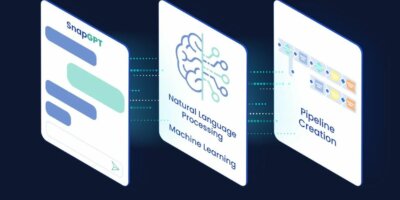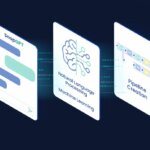
IT teams are competing among other business units to lead generative AI initiatives (Image generated by AI)
For the love of IT: What it takes to lead in the age of Gen AI
This article has been contributed by Jeremiah Stone, CTO, SnapLogic
I remember when I first fell in love with technology. I’d always wanted to help the world be a better place and from an early age I thought that this would mean going into medicine. But in the course of my university studies, I just kept taking more and more maths classes, and found myself drawn towards pure mathematics.
My father, ever the pragmatist, encouraged me to not confuse my vocation with my avocation, and I fulfilled the requirements for a computer science minor (this was the late 90’s and both Y2K and the dot.com boom were a big feature of the daily news at the time). I soon discovered the ability of data analytics and technology to directly impact people’s quality of life and how digital technology in particular was foundational to how the global economy operates. Since then, I’ve been trying to work as closely as I can on those really hard problems that have a meaningful impact in the world.
The role of the IT professional is often multi-faceted and varied, but ultimately one characteristic that ties us all together is our ability to solve problems. We’re always looking at the people, processes and technology to address issues, support progress and grow the business.
Now that we are working with gen-AI, the ability of IT to solve problems for the business, for our co-workers and for customers has never been greater. As such, gen-AI signifies a shift in the perception of IT professionals from technology stewards to stewards of positive change.
With a simple prompt, an IT pro can fix long-standing business problems more quickly and easily than ever, whether that means pulling data for a board meeting where critical decisions will be made, or instantly or knitting applications together to enable the delivery of new products and services. If being a data-oriented problem solver was a skill before, AI has made it a superpower.
The rise of ‘AI-nxiety’

Jeremiah Stone, CTO, SnapLogic
When the first generative AI programs started producing code, many in the technology world were – understandably – a little nervous about what this might mean for their jobs, not least as the tools continued to develop and mature. This AI-nxiety is of course not exclusive to IT, but nonetheless, foreboding predictions about the state of our industry in the not-too-distant future have hit the headlines in recent months and caused considerable concern.
But should we as IT professionals really be worried – or, as the optimist in me is inclined to say – is generative AI actually a great opportunity for IT leaders to drive our field and our businesses forward?
The reality is probably somewhere in between. In the short term, IT professionals will likely see their jobs have more importance, as their businesses look to them to help create the data ecosystems and delivery models necessary for the successful implementation of generative AI (gen-AI). Indeed, the input of IT teams in the governance, design and practical implementation of gen-AI will be absolutely critical, as any organization looking to stay ahead of the curve is trying to use gen-AI to problem-solve more efficiently while avoiding the creation of unknown business risk.
AI reshaping the business landscape
Interestingly, SnapLogic recently released its “State of Data and Analytics Australia and New Zealand 2023” report in partnership with Corinium, exploring the current challenges, opportunities and emerging trends as AI continues to transform the business landscape.
The results open much opportunity for organizations to rethink the impact of how AI is reshaping the landscape:
- High demand for expertise: 86% of respondents reported a notable increase in the demand for data and analytics expertise, indicating a sustained need for skilled professionals in the field.
- AI reshaping the landscape: AI emerges as a transformative force, with 89% of data leaders expecting a reduction in full-time hours in their organizations due to AI adoption. An overwhelming 90% believe that AI will drive the single greatest change in their data strategies over the next three to five years.
- Collaboration with cybersecurity: 98% of participants underscored the importance of closer collaboration between data leaders and cybersecurity teams, emphasizing the need to safeguard data in an increasingly digital landscape.
- CEO alignment: Only 6% of respondents report to their organization’s CEO, highlighting the limited direct connection between data and analytics leaders and top-level executives.
- Cloud data warehouses on the rise: The report reveals that 92% of respondents are utilizing cloud data warehouses across multiple business functions, reflecting a growing reliance on cloud infrastructure for data management.
In the longer term, the impact of gen-AI to the IT person will likely be one of evolution rather than replacement. I believe that gen-AI is in many ways simultaneously the most underhyped and overhyped technology today: why? Because there is unfortunately a widespread lack of concrete factual knowledge about how these systems operate and will operate in the broader media and tech community.
This has resulted in unfounded speculation and catastrophizing that is unhelpful and damaging to these technologies’ potential. The reality is that the way that AI and machine learning function are so different, compared to the core technologies that most people are used to, that there’s a lot of unfounded hyperbole rooted in misunderstanding.
There’s a quote often attributed to Socrates that says: “I know only one thing: that I know nothing”. I think that this can apply to a lot of the misconceptions around AI at the moment. We are barely scratching the surface of real-life applications of gen-AI technology. We know very little. Yes, some generative models are spookily accurate in their responses to both general and specific inputs, but can they really replace skilled humans? Definitely not right now.

The impact of gen-AI to the IT person will likely be one of evolution rather than replacement. (Image generated by AI)
Generative AI and integration
Generative AI is projected to have a profound impact on global business, with McKinsey estimating it could “add the equivalent of $4.4 trillion annually” through improvement of customer interactions, automation of business processes, conversational business intelligence, and IT acceleration via code generation. Unfortunately, companies seeking to capitalize on generative AI face prohibitive obstacles. McKinsey cites a lack of available AI skills, inaccuracy of results, and concerns about privacy and security as possible barriers to generative AI adoption in enterprises. SnapLogic plans to eliminate those obstacles.
SnapLogic recently unveiled GenAI Builder, the world’s first no-code generative AI application development product for enterprise applications and services. Uniquely compatible with both legacy mainframe data, modern databases and APIs, GenAI Builder leverages conversational AI to transform and simplify customer, employee and partner digital experiences.
As the latest addition to SnapLogic’s AI suite, GenAI Builder allows organisations to integrate AI with enterprise data to securely enhance the efficiency, accuracy, and personalisation of data for every enterprise employee. This applies to multiple types of data, whether in the cloud or on-prem. It can be applied to critical use cases from customer support automation, data analysis and reporting, contract and document review, to personalised marketing. GenAI builder puts the power of LLMs, and the scale of AI where it matters most; in the hands of every enterprise employee.
IT leads the way
As IT professionals we are in a unique position to lead from the front – to partner with AI in individual contexts and guide its utilisation and further development in business and beyond. The decisions we make and the problems we solve will define the AI space in the future.
IT staff are on the frontline of what is undoubtedly a technological revolution and it’s our job to steer the ship, guide our businesses and our colleagues and solve difficult problems for our customers.
For that reason, I urge IT colleagues to treat generative AI like a potential partner, not a competitor and not to be worried about a dystopian future or swayed by the hyperbole. IT teams are competing among other business units to lead generative AI initiatives, and there is an opportunity now for IT teams to deliver on the promise of information and imagination at work, supported by and delivered by digital technology.
Jeremiah Stone, CTO, SnapLogic
With more than two decades of experience, Jeremiah is a seasoned builder of advanced technology products and platforms that leverage the full power of AI to solve real business problems. He is responsible for guiding the continued development and future direction of SnapLogic’s Intelligent Integration Platform – with industry-leading AI and machine learning at its core – enabling customers to further speed the integration and automation process to drive breakthrough business results.
About SnapLogic
SnapLogic is the leader in Generative Integration. As a pioneer in AI-led integration, the SnapLogic Platform accelerates digital transformation across the enterprise and empowers everyone to integrate faster and easier. Whether you are automating business processes, democratizing data, or delivering digital products and services, SnapLogic enables you to simplify your technology stack and take your enterprise further. Thousands of enterprises around the globe rely on SnapLogic to integrate, automate and orchestrate the flow of data across their business.
Get your business data AI ready and join the Generative Integration movement at snaplogic.com.
Connect with SnapLogic via our Blog, Twitter, Facebook, or LinkedIn.
READ MORE
- 3 Steps to Successfully Automate Copilot for Microsoft 365 Implementation
- Trustworthy AI – the Promise of Enterprise-Friendly Generative Machine Learning with Dell and NVIDIA
- Strategies for Democratizing GenAI
- The criticality of endpoint management in cybersecurity and operations
- Ethical AI: The renewed importance of safeguarding data and customer privacy in Generative AI applications




